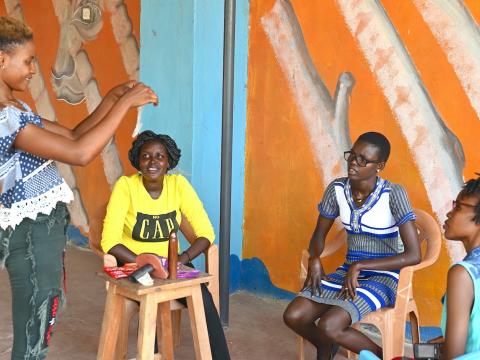Youth champion spearheads HIV prevention initiatives in Turkana

By Sarah Ooko, World Vision Senior Communications and Media Officer, Kenya
Jamillah, in her twenties, is a HIV peer educator in Lodwar - a rural town situated in Turkana County, Kenya. When she was infected with HIV, close to a decade ago, she became stressed and thought her life had come to an end.
"I was young, in my teens, with my entire life ahead of me. But due to peer pressure, I dropped out of school and began engaging in risky behaviours that led to me getting HIV," she says.

After being diagnosed with the disease, Jamillah was initially in denial and would not listen to advice from her doctors.
"The diagnosis shocked me. Initially, I refused to take the HIV treatment medicine known as Antiretroviral (ARV) drugs. But after I became really sick, I changed my mind and began using them as I did not want to die," she says.

Through continuous counselling and encouragement by a HIV youth support group at her health facility, Jamillah eventually came to terms with her condition and turned her life around.
Thanks to this intervention, Jamillah went back to school to complete her education and decided to become a HIV peer educator.

She is among the many youth HIV prevention champions empowered by World Vision in collaboration with the Kenya Red Cross and the government, through funds donated by The Global Fund.
These champions are playing a key role in reducing HIV infections rates among young people which is an issue of great public health concern in Kenya.

A joint report by the National AIDS Control Council (NAC) and the National AIDS and STI Control Programme (NASCOP) indicates that AIDS is the leading cause of death and morbidity (disease related suffering) among adolescents and young people (aged between 15 and 24) in Kenya.
This age group currently accounts for approximately 42 percent of all adult new HIV infections in the country. Yet, their access and adherence to treatment, which is crucial for their survival and improved well-being, is still considered sub-optimal.
Consequently, Kenya's Ministry of Health (MOH) highlights the crucial need to pay special attention to the sexual risks and prevailing challenges that make this young population vulnerable to HIV infection.

Guided by this goal, Jamillah has been steadfast in creating awareness on HIV prevention and encouraging her peers to avoid risky behaviours that put them at risk of infection such as unprotected sex, multiple sexual partners, alcoholism and drug abuse.
"Poverty levels are high in Turkana. This pushes many young people to engage in risky behaviours like commercial sex work for money or to indulge in alcoholism to cope with the stress. I have been letting my fellow youth know that these options will do them more harm than good in the long term. These issues can also be addressed by supporting young people to engage in income generating activities that can sustain them," she says.

According to Jamillah, most young people usually have no problem with taking their ARV drugs, once they understand their importance.
"But what discourages them from testing for HIV and adhering to treatment thereafter, is the fear of being stigmatised by their loved ones.This is why we need to stop discriminating against people with HIV. Instead, we should be more caring, loving and supportive," she says.

Jamillah's decision to speak openly about her HIV positive status and lead a normal life full of joy and happiness, has inspired many more young people to undergo testing and embrace the recommended treatment.
"It is important to do everything possible to prevent HIV infection.But for those who already have the disease, it is important to know that HIV is not a death sentence. If you take your ARVs and embrace a healthy lifestyle, you will still be able to live a normal life like others and achieve all your dreams in life," she says.
The concerted efforts of peer educators like Jamillah have immensely contributed to a reduction in new HIV infections among young people in the country by about 40 percent (from 35,776 in 2016 to14,410 as per the latest statistics released in 2020).